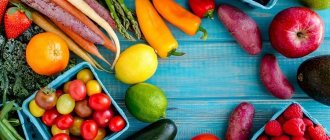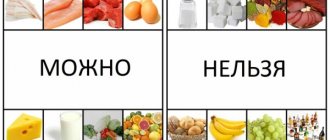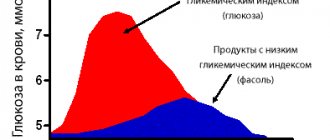Insulin deficiency in type 1 diabetes manifests itself in insufficient secretion of this hormone by the pancreas. Therefore, the only way to treat the pathology is to administer insulin through injections. To avoid overdose, there are rules for the diet and composition of the diet. Patients should achieve an accurate distribution of carbohydrate foods per day and calculate their calorie content. A table of bread units for type 1 diabetics will help with this.
Carbohydrates in the diet
Why do diabetics need tables?
There are digestible and indigestible sugars. The first include fast carbohydrates, which are absorbed within 10 minutes. These are sucrose, glucose, maltose, lactose, fructose. They are quickly absorbed in the digestive organs and enter the circulatory system.
Slow carbohydrates (starch) are digested within 25 minutes. Indigestible dietary fiber (pectin, cellulose, guar) and cellulose do not affect sugar levels. To calculate the number of digestible carbohydrates and the amount of hormone administered, a diagram of bread units (XE) was created for diabetics.
Important! 1 XE is considered to be 10-12 g of fast carbohydrates (approximately 50 kcal). Each unit increases sugar by 2.7 mmol/l.
Using accurate data from the tables, you can diversify your diet without the risk of increasing your carbohydrate load. For example, instead of soup, eat another dish with a similar XE content. Having information about each product, a diabetic can be sure that he will administer the necessary dosage of the hormone so that the food does not cause complications.
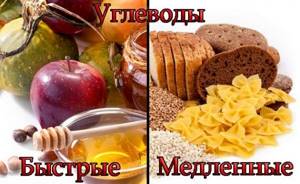
Fast and slow carbohydrates
Bread diet for weight loss according to Israeli and German methods: their features and menu for the week
Almost any diet involves limiting carbohydrates. Weight is lost by reducing energy consumption.
On the other hand, this is precisely what entails decreased performance, lethargy and a constant feeling of hunger. However, a new nutrition system has emerged that goes against the usual postulates.
This is the bread diet, which Olga Raz-Kestner, an Israeli nutritionist, first told the world about.
Effect on the body
It is well known that the main enemy of a beautiful figure is carbohydrates. It is on this statement that most nutritional systems that promote weight loss are based: they advocate either complete or partial rejection of high-calorie foods.
Olga Raz was able to experimentally prove the opposite. Her main discovery was the fact that low-carb diets reduce serotonin levels in the body. This is the same hormone of happiness.
It is not difficult to guess what happens to a person when he loses this little wizard.
The mood deteriorates sharply, the appetite grows, and the feeling of hunger eventually becomes almost uncontrollable.
The bread diet avoids these side effects. It provides the body with the necessary amount of carbohydrates, and meanwhile, weight loss will occur by limiting other foods and portion sizes.
The basis is low-calorie bread, which is made from whole flour (bran, rye) or bread. It contains a lot of vitamins (E, B1, B2), minerals (magnesium, phosphorus, calcium, potassium, etc.). The maximum number of calories consumed is limited to 35-45.
The actual mechanism for losing weight is extremely simple: bread rich in coarse fibers does not provoke a sharp release of glucose and insulin. Energy is produced by the body more slowly and is consumed gradually. As a result, no fat deposits are formed in problem areas.
A bread fast can last quite a long time, as it does not limit physical activity and does not reduce performance. But usually it lasts for a week. And don’t expect stunning results: they will be minimal (4 kg), but lasting.
Recommendations
To lose weight on bread without harm to your health, you need to follow certain rules. It’s worth mentioning right away that the nutrition system from Olga Raz formed the basis for many other methods for combating excess weight. Each of them has its own nuances, but we will prescribe postulates common to all, since the main product is one - bread.
- Eat small and often meals (at least 5 times a day).
- Meals should be at the same time.
- The interval between them should not exceed 4 hours.
- It is strictly forbidden to skip them, even if there is no feeling of hunger.
- The drinking regime involves drinking 2 liters of water.
- The main product is dietary bread. In extreme cases, it can be replaced with rye, but in this case the portion is reduced by 2 times.
- Since the diet is not varied, it is advisable to take multivitamins.
- Exercising will speed up the burning of fat deposits. If you feel weak and unwell, provide at least light physical activity. This could be walking, skipping rope, yoga or dancing.
- To prevent lost kilograms from returning, exiting the diet should be gradual: follow a diet, drink plenty of fluids, do not eat white bread, replace sugar with honey or stevia.
The stricter the diet, the more accurately you adhere to its rules, the more beneficial it will be for your health and the better the results will be.
Contraindications
You should not use bread for weight loss if you have the following contraindications:
- pregnancy;
- lactation;
- children's and elderly age;
- any problems with the gastrointestinal tract;
- inflammatory processes in the liver and gall bladder.
Do not forget that bread is a high-calorie product that cannot be eaten in large quantities if you have certain diseases.
Advantages and disadvantages
In order for a diet to help achieve the desired results without harm to health, it is worth assessing its positive and negative aspects in advance.
Advantages:
- promotes weight loss even if you are obese;
- allowed for atherosclerosis, diabetes;
- removes free radicals, toxins, heavy metal salts, waste, excess liquid;
- hunger is not felt at all;
- compatibility with physical activity;
- budget;
- unlimited terms;
- weight does not return (with proper exit);
- slight and gradual weight loss leads to the absence of sagging skin, stretch marks, and depletion of muscle mass;
- the craving for sweets is dulled.
Flaws:
- the lack of proteins can still negatively affect muscle mass;
- lack of fat can worsen metabolism;
- deficiency of calcium and vitamins.
To ensure that the results do not disappoint you, take into account all the disadvantages and try to somehow eliminate them, following the recommendations of experts.
Israeli bread diet
After the unique discovery of Olga Raz, other nutritional systems based on losing weight with bread were created. Therefore, you have a choice which of the modern methods suits you best than others. But the most popular is still the Israeli bread diet from a professional in his field. It involves 2 stages.
Stage I
At this stage, active weight loss occurs. It is allowed to eat low-calorie bread with a thin layer of “spread” with a minimum amount of fat. On the day it is recommended to eat:
- women - up to 12 pieces;
- for men - up to 16.
The diet is supplemented with protein foods and vegetables. The duration of the stage is 2 weeks.
Authorized products:
- sandwiches with cottage cheese (up to 5% fat), fish (even salted), lean meat (chicken, turkey, quail, beef, veal);
- ham;
- vegetables without starch: cabbage, zucchini, bell peppers, tomatoes, broccoli, asparagus, green peas, lettuce;
- eggs (three times a week);
- fermented milk drinks (yogurt, fermented baked milk and kefir) - a glass a day;
- three times a week you need to eat meat or fish with vegetables, but on such days the serving size of bread is reduced by a third;
- fruits: plums, avocados, apples, pears (1 piece per day);
- vegetable oil in small quantities for salad dressing;
- coffee (occasionally), green tea, vegetable juices (celery, tomato, carrot).
Stage II
This stage represents consolidation of the achieved results. The goal is not to regain lost weight. The diet is gradually expanded with other products. The duration of the stage depends on individual indicators. On average - 2-3 weeks.
Authorized products:
- porridge;
- pasta;
- potatoes (1 piece per day);
- legumes: beans, lentils;
- the portion of fruit increases (3 pieces per day).
For both stages there is a list of prohibited products:
- sweets: honey, sugar, sweets, confectionery, chocolate, marmalade;
- smoked foods, pickles, sauces, marinades;
- alcohol;
- ketchup, mayonnaise;
- carbonated drinks;
- bakery;
- preserves and jams;
- food with animal fats;
- fat meat;
- some dairy products: milk, homemade cottage cheese, sour cream.
With such a diet, fats practically do not enter the body, which means that it will not have the opportunity to store them in reserve.
Diet based on bread units
The German diet based on bread units is structured differently - a low-carbohydrate nutrition program recommended for patients with diabetes. Similarities with Olga Raz’s system are in a balanced and varied diet and duration. The basis is the calculation of the daily carbohydrate intake.
All products are measured in bread units (XU) to provide an approximate estimate of their carbohydrate content:
- 1 XE = 10 grams of carbohydrates (without dietary fiber);
- 1 XE = 13 grams of carbohydrates (with ballast substances);
- 1 XE = 20 grams of bread.
It is usually recommended to consume no more than 30 XE per day. The daily norm can be distributed as follows:
- 4 XE - in main meals;
- 2 XE - for an afternoon snack;
- You cannot consume more than 7 XE at a time.
However, a diet based on bread units reduces their daily amount to 10. For calculation, German nutritionists have developed a special table. If it does not contain a certain product, its use as part of weight loss is not limited.
Sample menu
The bread diet is difficult, first of all, in creating a menu. To make this task easier, we offer you an approximate option for 7 days using the system from Olga Raz:
Menu for the week based on bread units
If you can’t go on a diet because you feel hungry, it makes sense to turn to this weight loss method. Bread, despite all its caloric content, will allow you to put your diet in order, improve your well-being, and most importantly, it will not allow you to suffer due to lack of energy. With this product, it is much easier to fight excess weight than with any other mono-diet - you can see this for yourself.
Source: https://hudeyko.ru/hlebnaya-dieta-dlya-pohudeniya.html
Bolus calculation
When carrying out insulin therapy, they strive to bring it as close as possible to the physiological secretion of insulin. The combined administration of hormones with prolonged (base) and short-term effects (bolus) helps to imitate the work of the pancreas.
Insulin requirements are constantly changing. This depends on the quality and quantity of food consumed, weight, age, condition (pregnancy in women, growing up in a child). A self-monitoring diary helps you calculate the dosage of the hormone. The doctor calculates the initial dose experimentally and then adjusts it. During this time, laboratory tests of blood and urine are carried out.
Important! For 1 XE you need from 1 to 4 units (on average they take 2 units) of short-acting insulin.
During the day, 1 XE requires different amounts of hormones. Let's look at the calculations using an example:
1 XE is equivalent to 12 g of sugar. This corresponds to 25 g of bread. Since 1 XE increases sugar by approximately 2 or 2.77 mmol/l, to compensate for it you will need 2 units of insulin in the morning, half a unit less at lunch and one unit administered in the evening.
XE calculations for diabetes mellitus
To find out how many bread units to consume per day, calculate the energy value of the diet and determine the number of kcal that a person consumes with carbohydrate foods.
One gram of simple sugars is equal to 4 kcal, so divide the result by four. Thus, the daily requirement of carbohydrates is obtained and divided by 12.
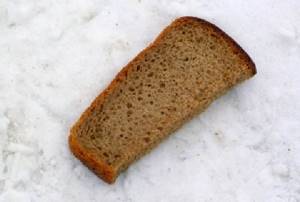
HE
For example, carbohydrate energy value is 1200 kcal:
- 1200 kcal / 4 kcal = 300 g carbohydrates.
- 300 g / 12 g = 25 carbohydrate units.
To avoid complications, endocrinologists recommend consuming 7 carbohydrate units at a time. The menu is prescribed so that the main carbohydrate load occurs before dinner.
Important! The more carbohydrate-containing foods you eat, the more difficult it is to control your blood sugar! Normally, the administration of short-acting insulin should not exceed 14 units per day.
Approximate distribution of XE per day for diabetes mellitus:
- breakfast – 7;
- lunch – 7;
- dinner – 5.
A total of 19 carbohydrate units. The remaining 5 are distributed for snacks and 1 XE at night. Such measures are mandatory for those who are at risk of low sugar after a main meal. This usually happens when administering long-acting insulins.
Ready main courses
| Product | 1 XE in grams of product |
| Fried eggplants | 235 |
| Lamb (fried, boiled, stewed) | — |
| Beef Stroganoff | 203 |
| Beef steak | — |
| Beef (fried, boiled, stewed) | — |
| Buckwheat porridge with milk | 49 |
| Beef goulash | 364 |
| Goose (fried, boiled, stewed) | — |
| Roast (mushrooms and chicken) | 132 |
| Roast beef | — |
| Roast chicken | 136 |
| Roast pork | — |
| Turkey (fried, boiled, stewed) | — |
| Stewed cabbage | 245 |
| Fried cabbage | 226 |
| Mashed potatoes with added milk | 102 |
| Fried potato | 48 |
| Baked potatoes | 75 |
| Beef cutlets | 182 |
| Turkey cutlets | 138 |
| Chicken cutlets | 111 |
| Fish cutlets | 110 |
| Pork cutlets | 110 |
| Boiled chicken | — |
| Beef pilaf | 59 |
| Lamb pilaf | 50 |
| Boiled fish | — |
| Fish and chips | 138 |
| Pork (fried, boiled, stewed) | — |
| Duck (fried, boiled, stewed) | — |
Daily norm of XE for normal weight
There are special programs or calculator for determining the exact carbohydrate units. However, the patient should calculate XE after consulting a doctor, since the indicators depend on the weight, physical activity and gender of the diabetic. For example, men who perform heavy physical labor require more XE. The number of carbohydrate units is counted for patients, taking into account their activity:
- high physical activity – 30;
- average activity – 18-25;
- physical inactivity – 15.
XE tables for type 1 and type 2 diabetes
In order not to calculate the weight of products per 1 XE each time, it is recommended to use ready-made tables taking into account the energy value. It is better to print them out and use the data when cooking. Meat products, offal and other protein foods contain virtually no carbohydrates. An exception may be sausages.
Juices

Table of XE in juices
| 1 XE/g | Carbohydrates, g | Kcal | |
| 100 g | 100 g | ||
| Apricot | 88 | 13,7 | 56 |
| Quince with pulp | 91 | 13,2 | 53 |
| Orange | 94 | 12,8 | 54 |
| Grape | 87 | 13,8 | 54 |
| Cherry with pulp | 105 | 11,4 | 49 |
| Pomegranate | 83 | 14,5 | 64 |
| Grapefruit | 150 | 8,0 | 36 |
| Tangerine | 133 | 9,0 | 43 |
| Carrot-apple | 148 | 8,1 | 35 |
| Peach | 71 | 17,0 | 66 |
| Plum | 75 | 16,1 | 66 |
| Plum with pulp | 110 | 10,9 | 44 |
| Blackcurrant | 152 | 7,9 | 40 |
| Chokeberry | 162 | 7,4 | 32 |
| Apple | 160 | 7,5 | 38 |
| Tomato juice | 343 | 3,5 | 19 |
| carrot juice | 207 | 5,8 | 28 |
| Apricot compote | 57 | 0,2 | 85 |
| Grape compote | 61 | 0,5 | 77 |
| Pear compote with xylitol | 194 | 0,2 | 52 |
| Peach compote with xylitol | 197 | 0,5 | 52 |
| Apple compote with xylitol | 203 | 0,3 | 55 |
| Apple-grape drink | 94 | 0,4 | 51 |
| Apple-carrot drink | 75 | 0,3 | 62 |
Fruits

Table of XE in fruits
| 1 XE/g | Carbohydrates, g | Kcal | |
| 100 g | in 100 g | ||
| Grape | 80 | 15,0 | 65 |
| Apple | 122 | 9,8 | 45 |
| Apricots | 133 | 9,0 | 41 |
| Cherry plum | 188 | 6,4 | 27 |
| Quince | 152 | 7,9 | 40 |
| Cherry | 117 | 10,3 | 52 |
| Pomegranate | 107 | 11,2 | 52 |
| Pear | 126 | 9,5 | 42 |
| Figs | 107 | 11,2 | 49 |
| Plum | 125 | 9,6 | 43 |
| Cherries | 113 | 10,6 | 50 |
| Peaches | 126 | 9,5 | 46 |
| Dogwood | 133 | 9,0 | 44 |
| Gooseberry | 132 | 9,1 | 43 |
| Banana | 57 | 21,0 | 89 |
| Orange | 148 | 8,1 | 40 |
| Grapefruit | 185 | 6,5 | 35 |
| Lemon | 400 | 3,0 | 33 |
| Tangerines | 148 | 8,1 | 40 |
| Persimmon | 91 | 13,2 | 53 |
| Watermelon | 136 | 8,8 | 38 |
| Pumpkin | 286 | 4,2 | 25 |
| Melon | 132 | 9,1 | 38 |
| Dried apricots | 23 | 53,0 | 227 |
| Dried apricots | 22 | 55,0 | 234 |
| Raisin | 18 | 66,0 | 262 |
| Dried pear | 24 | 49,0 | 200 |
| Prunes | 21 | 57,8 | 242 |
| Dried apples | 27 | 44,6 | 199 |
| Black currant | 164 | 1,0 | 38 |
| Red Ribes | 164 | 0,6 | 39 |
| Blackberry | 273 | 2,0 | 31 |
| Garden strawberries | 190 | 0,8 | 34 |
| Raspberries | 145 | 0,8 | 42 |
| Sea buckthorn | 240 | 0,9 | 52 |
| Mulberry | 100 | 0,7 | 52 |
| Rose hip | 120 | 1,6 | 51 |
Vegetables

Table of XE in vegetables
| 1 XE/g | Carbohydrates, g | Kcal | |
| 100 g | 100 g | ||
| Potato | 74 | 16,3 | 80 |
| Beet | 132 | 9,1 | 42 |
| Carrot | 167 | 7,2 | 34 |
| Ground cucumbers | 462 | 2,6 | 14 |
| Greenhouse cucumbers | 667 | 1,8 | 10 |
| Pickles | 923 | 1,3 | 19 |
| Ground tomatoes | 316 | 3,8 | 23 |
| Greenhouse tomatoes | 414 | 2,9 | 20 |
| Zucchini | 245 | 4,9 | 23 |
| Eggplant | 235 | 5,1 | 24 |
| Swede | 162 | 7,4 | 34 |
| White cabbage | 255 | 4,7 | 27 |
| Sauerkraut | 667 | 1,8 | 14 |
| Red cabbage | 197 | 6,1 | 31 |
| Cauliflower | 267 | 4,5 | 30 |
| Salad | 522 | 2,3 | 17 |
| Sweet red pepper | 226 | 5,3 | 27 |
| Sweet green pepper | 226 | 5,3 | 26 |
| Green onion (feather) | 343 | 3,5 | 19 |
| Leek | 185 | 6,5 | 33 |
| Bulb onions | 132 | 9,1 | 41 |
| Garlic | 231 | 5,2 | 46 |
| Dill | 267 | 4,5 | 32 |
| Parsley (greens) | 150 | 8,0 | 49 |
| Parsley (root) | 114 | 10,5 | 53 |
| Celery (greens) | 600 | 2,0 | 8 |
| Celery (root) | 218 | 5,5 | 30 |
| Spinach | 600 | 2,0 | 22 |
| Sorrel | 400 | 3,0 | 19 |
| Rhubarb | 480 | 2,5 | 16 |
| Turnip | 226 | 5,3 | 27 |
| Radish | 316 | 3,8 | 21 |
| Radish | 185 | 6,5 | 35 |
| Horseradish | 158 | 7,6 | 44 |
| Fresh porcini mushrooms | 1 091 | 1,1 | 30 |
| Dried white mushrooms | 158 | 7,6 | 150 |
| Fresh chanterelles | 800 | 1,5 | 20 |
| Fresh honey mushrooms | 2 400 | 0,5 | 17 |
| Fresh boletus | 857 | 1,4 | 23 |
| Dried boletus | 84 | 14,3 | 231 |
| Fresh boletuses | 1 000 | 1,2 | 22 |
| Fresh saffron milk caps | 2 400 | 0,5 | 17 |
| Fresh champignons | 12 000 | 0,1 | 27 |
| Canned olives | 231 | 5,2 | 175 |
| Cauliflower | 750 | 1,6 | 11 |
| Seaweed in tomato sauce | 158 | 7,6 | 84 |
| Stewed carrots | 136 | 8,8 | 71 |
| Carrots with prunes | 107 | 11,2 | 100 |
| Carrots with apricot puree | 103 | 11,7 | 39 |
| Zucchini | 141 | 8,5 | 117 |
| Pepper stuffed with vegetables | 106 | 11,3 | 109 |
| Eggplant caviar | 236 | 5,1 | 148 |
| Zucchini caviar | 141 | 8,5 | 122 |
| Beet caviar | 99 | 12,1 | 60 |
| Beet salad | 129 | 9,3 | 56 |
| Vegetable salad | 308 | 3,9 | 79 |
| Tomato paste | 63 | 19,0 | 99 |
| Tomato puree | 102 | 11,8 | 65 |
Dairy
| 1 XE/g | Carbohydrates, g | Kcal | |
| 100 g | 100 g | ||
| Skim milk | 255 | 4,7 | 31 |
| Cream 10% fat | 293 | 4,1 | 118 |
| Sour cream 20% | 375 | 3,2 | 206 |
| Cottage cheese semi-fat 9% | 600 | 2,0 | 159 |
| Low-fat cottage cheese | 632 | 1,9 | 88 |
| Sweet curd mass | 78 | 15,4 | 286 |
| Glazed cheese curds | 38 | 32,0 | 407 |
| Acidophilus | 308 | 3,9 | 57 |
| Kefir 1% | 226 | 5,3 | 49 |
| Curdled milk | 293 | 4,1 | 58 |
| Yogurt 1.5% without sugar | 343 | 3,5 | 51 |
| Yogurt 1.5% sweet | 141 | 8,5 | 70 |
| Ryazhenka 6% | 293 | 4,1 | 84 |
| Curd whey | 343 | 3,5 | 20 |
| Condensed milk with sugar | 21 | 56,0 | 320 |
| Ice cream sundae | 58 | 20,8 | 227 |
Bakery products
| 1 XE/g | Carbohydrates, g | Kcal | |
| 100 g | 100 g | ||
| Rye bread made from sifted flour | 26 | 46,1 | 220 |
| Wheat bread made from 1st grade flour | 24 | 50,4 | 238 |
| Diabetic rye bread | 31 | 38,4 | 214 |
| Simple loaf | 23 | 51,9 | 236 |
| Dried bread | 17 | 70,1 | 341 |
| First grade wheat flour | 17 | 69,0 | 334 |
| Bakery products made from 1st grade flour | 21 | 56,0 | 316 |
| Sweet bun | 22 | 7,9 | 337 |
| City bun | 22 | 7,7 | 254 |
| Bagels made from first grade flour | 19 | 10,4 | 317 |
| Bagels with poppy seeds | 21 | 8,1 | 316 |
| Drying from premium flour | 17 | 10,7 | 341 |
| Corn flour | 17 | 7,2 | 330 |
| Wheat flour | 17 | 10,3 | 334 |
| Rye flour | 19 | 6,9 | 304 |
Pasta and cereals
| 1 XE/g | Carbohydrates, g | Kcal | |
| 100 g | 100 g | ||
| Premium pasta | 17 | 69,7 | 337 |
| Semolina | 18 | 67,7 | 328 |
| Rice groats | 17 | 71,4 | 330 |
| Millet | 18 | 66,5 | 348 |
| Buckwheat (cereal) | 19 | 62,1 | 335 |
| Oatmeal | 24 | 49,7 | 303 |
| Pearl barley | 18 | 66,5 | 320 |
| Barley groats | 18 | 66,3 | 324 |
| Wheat groats "Artek" | 17 | 71,8 | 326 |
Nuts
| 1 XE/g | Kcal | |
| 100 g | ||
| Peanut | 85 | 375 |
| Walnuts | 90 | 630 |
| Cedar | 60 | 410 |
| Forest | 90 | 590 |
| Almond | 60 | 385 |
| Cashew | 40 | 240 |
| Seeds | 50 | 300 |
| Pistachios | 60 | 385 |
Ready soups
| Product | 1 XE in grams of product |
| Borsch | 364 |
| Ukrainian borscht | 174 |
| Mushroom broth | — |
| Lamb broth | — |
| Beef broth | — |
| Turkey broth | — |
| chicken broth | — |
| Vegetable broth | — |
| Fish broth | — |
| Mushroom okroshka (kvass) | 400 |
| Meat okroshka (kvass) | 197 |
| Meat okroshka (kefir) | 261 |
| Vegetable okroshka (kefir) | 368 |
| Fish okroshka (kvass) | 255 |
| Fish okroshka (kefir) | 161 |
| Mushroom rassolnik | 190 |
| Homemade rassolnik | 174 |
| Chicken rassolnik | 261 |
| Rassolnik Leningradsky | 124 |
| Meat rassolnik | 160 |
| Meat rassolnik | 160 |
| Rassolnik in Kuban style | 152 |
| Fish rassolnik | — |
| Rassolnik with kidneys | 245 |
| Rassolnik with beans | 231 |
| Solyanka mushroom | 279 |
| Pork solyanka | 250 |
| Solyanka meat team | 545 |
| Vegetable solyanka | 129 |
| Fish solyanka | — |
| Solyanka with squid | 378 |
| Solyanka with shrimps | 324 |
| Solyanka with chicken | 293 |
| Pea soup | 135 |
| Mushroom soup | — |
| Green pea soup | 107 |
| Cauliflower soup | 245 |
| Lentil soup | 231 |
| Potato soup with pasta | 136 |
| Potato soup | 182 |
| Onion soup | 300 |
| Milk soup with vermicelli | 141 |
| Milk soup with rice | 132 |
| Vegetable soup | 279 |
| Soup with meatballs | 182 |
| Cheese soup | 375 |
| Tomato soup | 571 |
| Bean soup | 120 |
| Sorrel soup | 414 |
| Pink salmon soup | 261 |
| Crucian fish soup | 500 |
| Carp soup | 293 |
| Canned soup | 218 |
| Salmon soup | 480 |
| Salmon soup | 324 |
| Pike perch fish soup | 375 |
| Trout soup | 387 |
| Pike soup | 203 |
| Fish soup in Finnish | 214 |
| Rostov fish soup | 273 |
| Fishing soup | 226 |
| Kharcho | 240 |
| Beetroot | 500 |
| Sauerkraut cabbage soup | 750 |
| Fresh cabbage soup | 375 |




